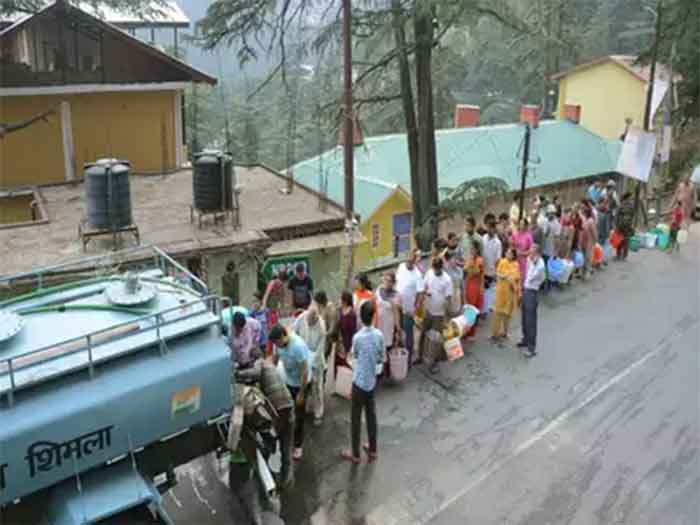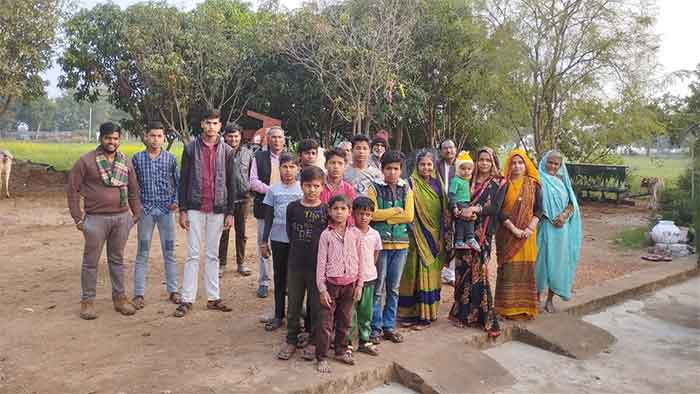
Tourism as an economic activity has boomed substantially and is adding to local and seasonal pressures on the water supply systems of tourist destinations worldwide.[i] The fact that the theme of the 2013 UN World Tourism Day highlighted tourism’s contribution to water access serves as an example of how the issue of water use by the tourism industry has garnered attention in previous years.
A 2016 UN Environmental Programme report noted that the “demand for fresh water is likely to outstrip supply by 40% by 2030 and a third of the world’s population will be living in areas of severe water stress by this time. In most countries, water consumption per guest in hotels vastly exceeds that of the local population.” For the entire world, and Travel and Tourism in particular, water scarcity is a significant problem.[ii] In the past few years, water crisis has been reported which directly impacts tourism.
A water crisis experiences in Shimla, Bali, Goa, Ladakh, Chennai and Hampi
Shimla, a city of hills in northern India, was hit hard by a severe water crisis in 2018, leaving locals in shock. The majority of the city only got water once every eight days. Residents waited hours for water tankers to arrive as there were long lines at the public taps. Authorities in the city were compelled to warn visitors to remain away due to a lack of water. Because tourists stayed away from the parched city, local businesses and hotels incurred losses.[iii] On an identical issue, Bali, a tropical tourist destination in Indonesia, grappled with a worsening water problem due to growing tourism, population growth, and poor water management.[iv] Goa has also become a victim of its success and experiencing severe water problems. Increased privatisation and poor management of Goa’s coastline are occurring due to the state government’s push for high-end tourism, which is characterised by its five-star resorts with swimming pools and golf courses, which significantly burdens the area’s already-stressed infrastructure and freshwater resources (Anabel da Gama).[v] The viability of Goa as a tourist destination and the welfare of the native populations are both at risk due to these problems. In Ladakh, a significant increase in visitors was observed in 2022, and experts claimed it led towards an adverse effect on the ecosystem and a water deficit in the Himalayan region.[vi] Similarly, in 2019, the impact of a water deficit brought on by the delayed monsoon was felt most severely in Chennai. As a result, the city’s hotels also experienced a water shortage.[vii]
Prabhu Patil, a senior tour guide from Hampi, stated that while the summer months bring in the most visitors, there are also times when water problems are reported. “Two RO plants, one near Vijaya Vittala temple and another near Lotus Mahal have remained defunct for the last few months and the authorities have not bothered to rectify it. Several tourists complained and demanded the authorities must ensure clean drinking water for all,” the official stated.[viii]
Water scarcity and Tourism
The tourism sector is a major consumer of water in certain popular tourist destinations, putting further stress on water resources in regions already suffering from some form of water scarcity.[ix] When the supply of safe, usable water in a given region is insufficient to meet demand, water stress or scarcity occurs.[x] In many cases, tourists are often unaware of local water scarcity issues.[xi]
Moreover, the existence of tourism necessitates the need for more people to have access to fresh water for various purposes, including drinking, hygiene, cleaning, food preparation, recreation, aesthetics, and other support services. This extra demand could cause stress in some places.[xii]. For instance, tourist water use in Fiji and Sri Lanka is 8.5 and 8.3 times greater than that of locals, respectively, according to a study on water disparity.[xiii]
The tourism sector must offer a remedy rather than being a significant contributor to the problem. Visitors need to be made aware of how they can conserve water. To overcome the obstacles, travellers must also play a part.
Contrarily, on a beneficial note, a positive shift ripple can be created by adapting to the solutions from the examples below of a few frontrunners tackling water problems.[xiv]
| · Amphiro products make water use apparent in the shower, where it is most frequently wasted. With the image of a polar bear standing on a melting iceberg as shower time drags on, these goods demonstrate how much water is actively being used. The Student Hotel in Amsterdam discovered that hot water consumption had decreased by 17% as a result of using Amphiro products.
|
| · The luxury resort Joali Maldives neglects to mention all of its environmental achievements on its website. However, it is renowned for its efforts and rigorous environmental protection standards. A desalination system that produces fresh water served in glass bottles, a composter designed especially for wet waste, and a rain-harvesting system are all on the property.
|
| · When washing laundry, Peninsula Hotels purposefully employs low water temperatures.
|
| · Since 2010, the Mantaray Island Resort in Fiji has treated all wastewater from the kitchen, laundry, and showers using a bio-gill wastewater treatment device. The property’s yard is fertilised with grey water and compost. Additionally, its desalination system has a daily output capacity of 60,000 litres (15,850 gallons).
|
|
|
| · Every structure on Chumbe Island in Tanzania has been planned to optimise water catchment during the rainy season. Grey water is also filtered by vegetation in each structure. In addition, the establishment filters and desalinates its water, which is then provided to visitors in reusable containers.
|
| · On Nikoi Island, seawater is used to fill the swimming area, and then desalinated water is used to top it off.
|
Additionally, tourism developments must have enough infrastructure and monitoring systems to manage and conserve potable water, sewage treatment (preferably tertiary treatment), untreated local wastewater, and the ultimate disposal of solid and liquid waste. Likewise, water tariffs must accurately represent the true service provision and maintenance cost. This will ensure that the use of water by the tourism industry is compatible with the water needs of the destination community, i.e., fulfil tourist expectations and support the livelihoods of local residents. Also, to regulate and monitor water, waste, and energy use, enforceable policies and legal frameworks should be in place. Tourism businesses, particularly hotels, should receive incentives to implement waste minimization, energy conservation, and water management practices.[xv] The International Tourist Partnership’s (ITP) Environmental Management programme offers these best practices.
While tourism poses a significant challenge to the sustainability of water resources. Tourism-related water use is still understudied.[xvi] It further requires careful study,[xvii] and there have been very few studies regarding the topic on tourism and water challenges to date. Lack of relevant data on tourism and water scarcity is another issue. The lack of studies on the topic could be attributable to a lack of data that prevents academics and policymakers from accurately estimating water consumption from tourism.[xviii] A study carried out in Spain was able to only estimate the average water consumption per tourist per day, due to the lack of official data on the water consumption of unregulated tourist accommodations .[xix] This is cause for concern, and more data is needed that can be applied to the different variables required for studies which can produce more accurate results.
Pema Choden Bhutia is a Research Scholar at Madras Institute of Development Studies, Chennai. Her research interests include tourism, ecotourism, environmental valuation techniques and tourist preferences.
Email: [email protected]
References
[i] Becken, S. (2014). Water equity – Contrasting tourism water use with that of the local community.Water Resources and Industry, 7–8, 9–22.
https://doi.org/10.1016/j.wri.2014.09.002
[ii]WTTC.https://worldtraveltourismcouncil.medium.com/water-scarcity-and-stewardship-d4bb78da0a5d
[iii] https://www.worldbank.org/en/news/feature/2019/08/01/shimla-water-security
[iv]https://abcnews.go.com/Business/wireStory/balis-water-crisis-threatens-local-culture-unesco-sites-95133235
[v] http://www.transforming-tourism.org/goal-6-clean-water-and-sanitation.html
[vi] https://www.indiatimes.com/explainers/news/in-ladakh-unprecedented-tourist-rush-causing-environmental-issues-water-shortage-582162.html
[vii] https://timesofindia.indiatimes.com/travel/destinations/travel-advisory-chennai-hotels-facing-water-shortage-due-to-delayed-monsoon/articleshow/69904363.cms
[viii] https://www.newindianexpress.com/states/karnataka/2022/jun/12/no-drinking-water-facility-aroundhampi-monuments-tourists-fume-2464731.html
[ix] Hadjikakou, M., Miller, G., & Chenoweth, J. (2013). Book chapter on “Water and Tourism” (pp. 435–446). https://doi.org/10.13140/RG.2.1.2356.5286
[x] https://www.cfr.org/backgrounder/water-stress-global-problem-thats-getting-worse
[xi] Hadjikakou, M. (2014). Measuring the Impact of Tourism on Water Resources:Alternative frameworks (PhD thesis) [PhD Thesis].
[xii] Becken, S. (2014). Water equity – Contrasting tourism water use with that of the local community. Water Resources and Industry, 7–8, 9–22.
https://doi.org/10.1016/j.wri.2014.09.002
[xiii] Becken, S. (2014). Water equity – Contrasting tourism water use with that of the local community. Water Resources and Industry, 7–8, 9–22.
https://doi.org/10.1016/j.wri.2014.09.002
[xiv] https://rootedstorytelling.com/environmental-issues/tourism-water-solutions/
[xv]https://www.gstcouncil.org/wp-content/uploads/Session9_GSTCEmrgDest_GiliBackKhiriTravel.pdf
[xvi] Gössling, S. 2005, “Tourism’s contribution to global environmental change: space, energy, disease, and water” in Tourism, recreation, and climate change, eds. C.M. Hall & J.E.S. Higham, Channel View Books, Clevedon, pp. 286
[xvii] Pérez, D. M. G., Martín, J. M. M., Martínez, J. M. G., & Sáez-Fernández, F. J. (2020). An Analysis of the Cost of Water Supply Linked to the Tourism Industry. An Application to the Case of the Island of Ibiza in Spain. Water, 12(7), 2006. https://doi.org/10.3390/w12072006
[xviii] Gössling, S. 2002, “Global environmental consequences of tourism”, Global Environmental Change, vol. 12, no. 4, pp. 283-302.
[xix] Pérez, D. M. G., Martín, J. M. M., Martínez, J. M. G., & Sáez-Fernández, F. J. (2020). An Analysis of the Cost of Water Supply Linked to the Tourism Industry. An Application to the Case of the Island of Ibiza in Spain. Water, 12(7), 2006. https://doi.org/10.3390/w12072006
















































